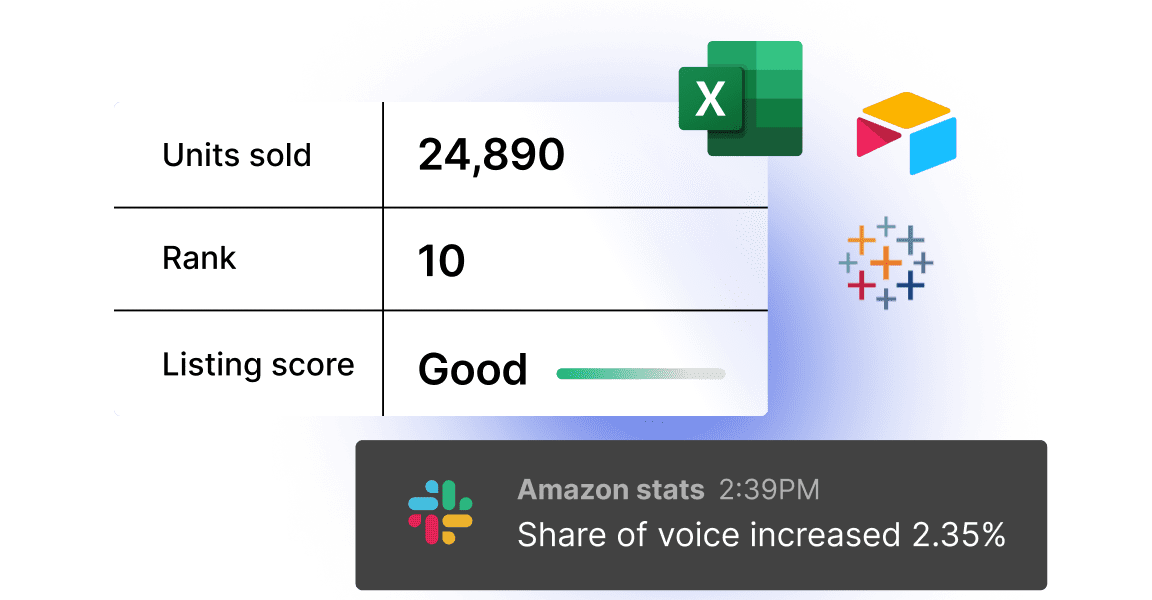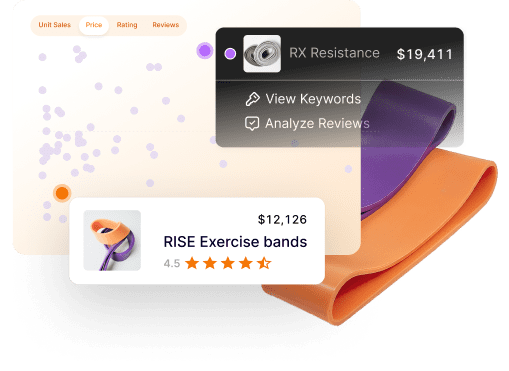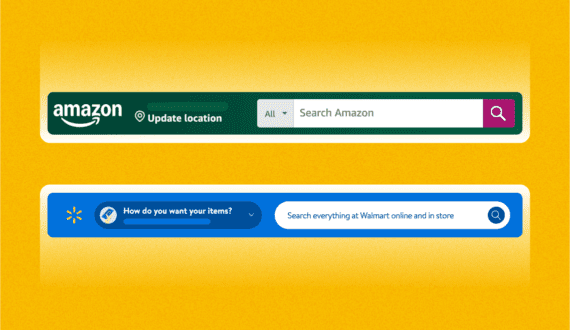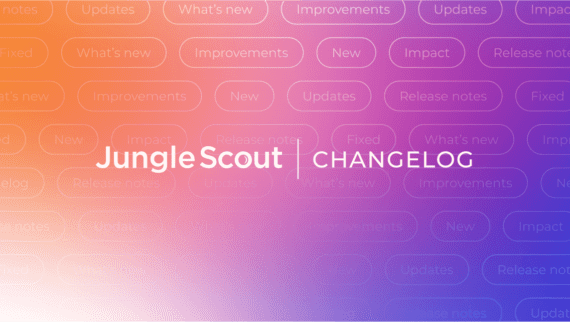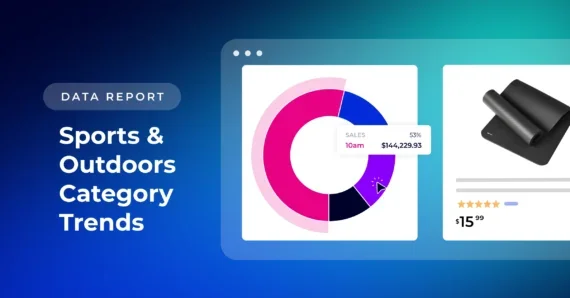If you haven’t heard by now, Jungle Scout Suite and Professional users can access our Amazon data API. This means you have billions of Amazon selling data points at your disposal to create custom tools and solutions for your Amazon businesses.
In this article, we will go over some of the ways you can use the API to build infinite tools and resources using industry-leading Amazon intelligence data.
10 ways to use the Jungle Scout Amazon API
The Jungle Scout API provides a powerful way for users to access and utilize Amazon data directly from Jungle Scout’s extensive database.

The possibilities of what you can build with the Jungle Scout API are endless, but here are ten potential use cases where developers and businesses can leverage this API to build innovative tools.
1. Market analysis and product discovery
Develop a tool that uses the Product Database query endpoint to filter products by categories, sales, and competition metrics and analyze trends to spot potential product opportunities.
2. Automated reporting
Develop a tool that regularly generates comprehensive reports on market trends, product performance, and competitive analysis. Use data visualization libraries (e.g., matplotlib in Python, ggplot2 in R) to generate informative charts and reports.
3. Product launch planning
Build a tool that assists sellers in identifying the best time to launch new products and planning marketing strategies based on market trends and historical data. Jungle Scout’s Amazon product API analyzes search trends, category sales, and competitive data to forecast the optimal launch window.
4. Amazon seller chatbot
A chatbot that provides instant product research and market analysis for sellers. Users can query the chatbot about product ideas, competition levels, estimated sales, and profitability in different marketplaces.
Utilize natural language processing (NLP) services (like Dialogflow or Microsoft Bot Framework) to interpret user queries and make requests to the Jungle Scout API for relevant data. The chatbot can then present this data in an easily digestible format, offering quick insights or suggestions directly through messaging platforms like Slack or a web interface.
5. Automated competitor analysis tool
Build an application that continuously monitors competitors’ product listings, pricing strategies, and sales performance. Leverage the Jungle Scout API to fetch data on competitors’ ASINs regularly. Analyze changes in price, customer reviews, and ranking. Present this data through an intuitive dashboard or send alerts when significant changes are detected.
6. Product trend spotter
A tool that identifies emerging trends in product categories by analyzing sales data, search volume, and market demand over time. Use the Jungle Scout API to track sales data and search trends across multiple categories. Employ time series analysis to spot growth trends and visualize these trends in an interactive web application or send periodic trend reports to users.
7. Customer insights analyzer
Build a tool that analyzes customer reviews and feedback for products across categories, providing insights into customer preferences, trends, and pain points. Analyze the data using text analysis and sentiment analysis techniques to extract useful insights.
8. Customer segmentation
Analyze search volume and sales data from the Jungle Scout API to identify patterns and preferences among different customer segments. Integrate this insight with marketing platforms to tailor email marketing, product recommendations, and promotional offers to different segments.
9. Brand monitoring
Monitor your brand’s performance on Amazon, tracking how your products stack up against competitors in terms of sales, reviews, and customer satisfaction.
10. Share of voice analysis
Use the Share of Voice endpoint to understand your brand’s or product’s visibility in Amazon search results compared to competitors. This can help in identifying opportunities to improve organic rankings or adjust PPC strategies for better visibility.
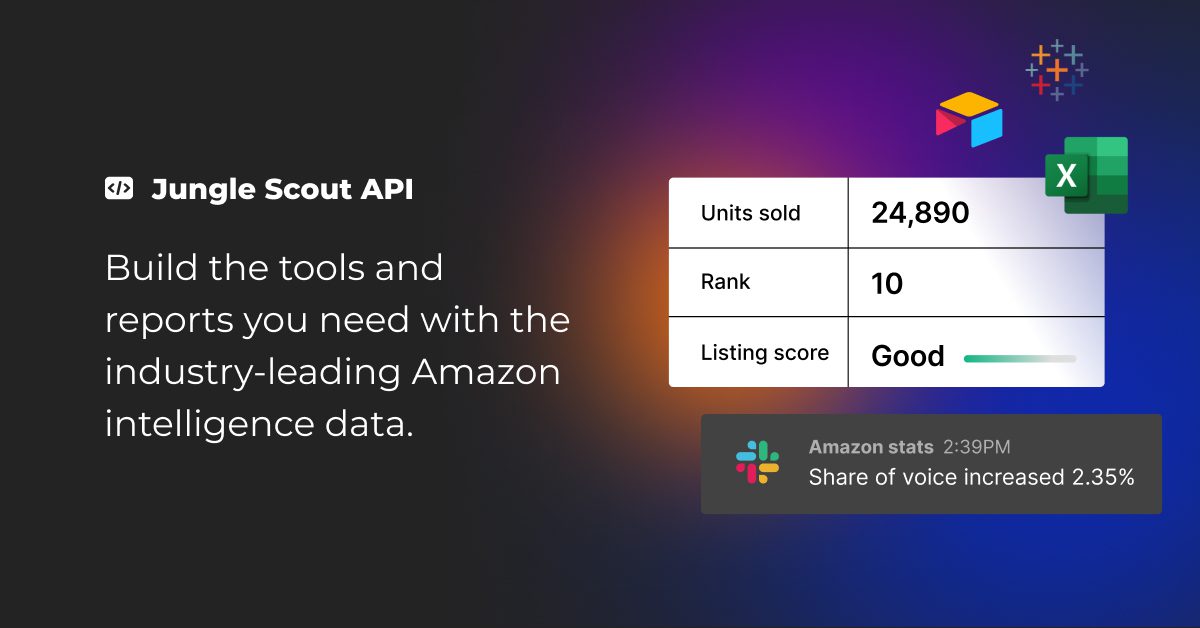
These use cases represent just a fraction of what’s possible with the Jungle Scout API. By accessing real-time and historical Amazon data, developers can create a wide range of tools and services to support their businesses or other sellers.
Start leveraging the power of Jungle Scout's API today.
Build a tool using the Jungle Scout API
Here we are going to show you an example of how to build a tool using the Jungle Scout API. In this example, we’ll build a tool that automatically pulls Amazon sales data from competitors’ products on a weekly basis into a Google Spreadsheet.
Step 1: Set up the Google spreadsheet
Open Google Sheets and create a new spreadsheet. Label the first row with headings that will correspond to the data you’ll be pulling. For example: “ASIN”, “Estimated Sales”, “Estimated Revenue”, “Date”.

Step 2: Access Google Apps Script
In your Google Spreadsheet, go to Extensions > Apps Script. A new tab for the script editor will open. This is where you’ll write the script to interact with the Jungle Scout API.


Step 3: Write the script
You can leverage AI to assist you in writing the script if you do not have experience with coding.
AI helped me write a script to build a tool with Google Apps Script that utilizes the Jungle Scout API to automatically pull sales data from competitors’ products on a weekly basis into a Google Spreadsheet.
To ensure the script is connected to the Jungle Scout API, you need to add the API Key that you get from your Jungle Scout account, and add the API URL. All requests must have https://developer.junglescout.com as its base address.
To learn how to properly structure your code in order to properly make an API call to the Jungle Scout API, use our Jungle Scout API Documentation.

Step 4: Save and test the script
Save your script by clicking the disk icon or selecting File > Save. Test the script by clicking the Run button. Review the data populated in your spreadsheet to ensure it’s pulling correctly.
Step 5: Schedule weekly execution
In the Apps Script editor, go to Triggers (clock icon on the left sidebar).
- Click + Add Trigger in the bottom right corner.
- Select the weeklySalesDataPull function.
- Choose “Time-driven” for the event source.
- Choose “Week timer” and select the day and time you want the script to run.
- Save the trigger.
Here is what populated in the spreadsheet after hitting run in Google Apps Script.

This is set to populate once per week so we can keep track of our competitor’s estimated daily sales and revenue! Once you have this data in Sheets, consider adding functionality to your script for organizing, analyzing, or visualizing your data directly within Google Sheets.
Connect the Jungle Scout API with Zapier
The Jungle Scout API now integrates directly with Zapier, allowing you to connect with thousands of popular apps, so you can automate certain tasks within your Amazon business.
By linking Jungle Scout with Zapier, you select a ‘trigger,’ an event that initiates the automation, and an ‘action,’ the event that follows the trigger.
For example, you can set up an automation that pulls weekly estimated sales data for a list of ASINs and automatically populates a Google Sheet.

What tools will you build with Jungle Scout API?
The Jungle Scout API is going to be a game changer for those who need access to Amazon’s data to build their own tools and solutions. What tools will you build with the API?
Learn more about how you can use the Jungle Scout API to build tools for your Amazon business.
Brian Connolly is an Amazon seller, ecommerce expert, and writer for Jungle Scout. He lives in the New Jersey Shore area with his wife and cat. When he isn’t writing advice online for aspiring and experienced Amazon sellers for Jungle Scout, he spends his free time boating, fishing, and selling boating-themed items on his Amazon business.

